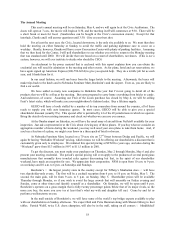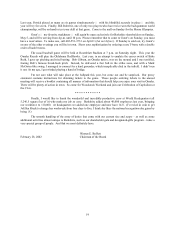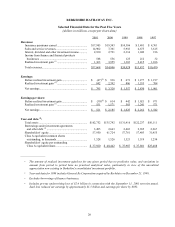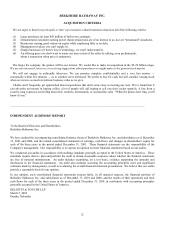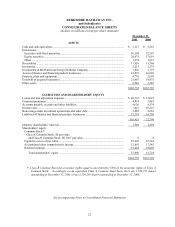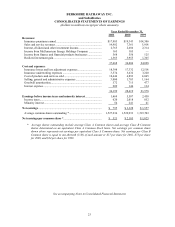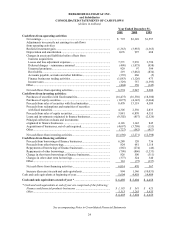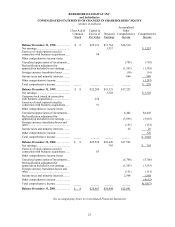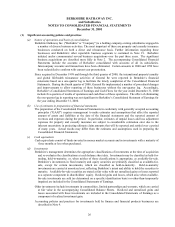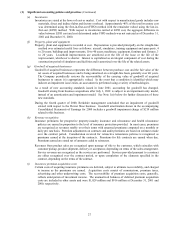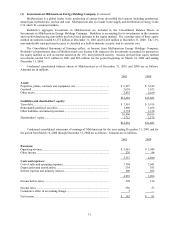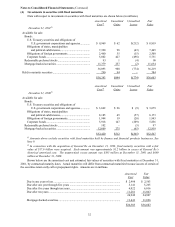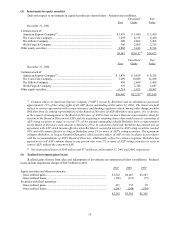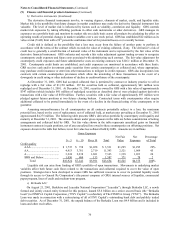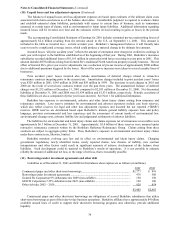Berkshire Hathaway 2001 Annual Report Download - page 29
Download and view the complete annual report
Please find page 29 of the 2001 Berkshire Hathaway annual report below. You can navigate through the pages in the report by either clicking on the pages listed below, or by using the keyword search tool below to find specific information within the annual report.28
Notes to Consolidated Financial Statements (Continued)
(1) Significant accounting policies and practices (Continued)
(j) Losses and loss adjustment expenses
Liabilities for unpaid losses and loss adjustment expenses represent estimated claim and claim settlement
costs of property/casualty insurance and reinsurance contracts. The liabilities for losses and loss
adjustment expenses are recorded at the estimated ultimate payment amounts, except that amounts
arising from certain reinsurance businesses are discounted as discussed below. Estimated ultimate
payment amounts are based upon (1) individual case estimates, (2) estimates of incurred-but-not-reported
losses, based upon past experience and (3) reports of losses from ceding insurers.
The estimated liabilities of workers’ compensation claims assumed by General Re under reinsurance
contracts and liabilities assumed under structured settlement reinsurance contracts by Berkshire
Hathaway Reinsurance Group are carried in the Consolidated Balance Sheets at discounted amounts.
Discounted amounts pertaining to General Re’ s workers’ compensation risks are based upon an annual
discount rate of 4.5%. The discounted amounts for structured settlement reinsurance contracts are based
upon the prevailing market discount rates when the contracts were written and range from 5% to 13%.
The periodic discount accretion is included in the Consolidated Statements of Earnings as a component
of losses and loss adjustment expenses.
(k) Deferred charges-reinsurance assumed
The excess of estimated liabilities for claims and claim costs over the consideration received with respect to
retroactive property and casualty reinsurance contracts that provide for indemnification of insurance risk
is established as a deferred charge at inception of such contracts. The deferred charges are subsequently
amortized using the interest method over the expected settlement periods of the claim liabilities. The
periodic amortization charges are reflected in the accompanying Consolidated Statements of Earnings as
losses and loss adjustment expenses.
(l) Reinsurance
Provisions for losses and loss adjustment expenses are reported in the accompanying Consolidated
Statements of Earnings after deducting amounts recovered and estimates of amounts recoverable under
reinsurance contracts. Reinsurance contracts do not relieve the ceding company of its obligations to
indemnify policyholders with respect to the underlying insurance and reinsurance contracts. Estimated
losses and loss adjustment expenses recoverable under reinsurance contracts are included in receivables.
(m) Foreign currency
The accounts of several foreign-based subsidiaries are measured using the local currency as the functional
currency. Revenues and expenses of these businesses are translated into U.S. dollars at the average
exchange rate for the period. Assets and liabilities are translated at the exchange rate as of the end of the
reporting period. Gains or losses from translating the financial statements of foreign-based operations are
included in shareholders’ equity as a component of other comprehensive income. Gains and losses
arising from other transactions denominated in a foreign currency are included in the Consolidated
Statements of Earnings.
(n) Accounting pronouncements to be adopted subsequent to December 31, 2001
In June 2001, the Financial Accounting Standards Board (“FASB”) issued two Statements of Financial
Accounting Standards (“SFAS”). SFAS No. 141 “Business Combinations” requires usage of the
purchase method for all business combinations initiated after June 30, 2001, and prohibits the usage of
the pooling of interests method. The provisions of SFAS No. 141 relating to the application of the
purchase method are generally effective for business combinations completed after July 1, 2001.
SFAS No. 142 “Goodwill and Other Intangible Assets” changes the current accounting model that requires
amortization of goodwill, supplemented by impairment tests, to an accounting model that is based solely
upon impairment tests. SFAS No. 142 also provides guidance on accounting for identifiable intangible
assets that may or may not require amortization. The provisions of SFAS No. 142 related to accounting
for goodwill and intangible assets will be generally effective for Berkshire at the beginning of 2002,
except, among other things, that goodwill and identifiable intangible assets with indefinite lives arising
from combinations completed after July 1, 2001 are not being amortized.


